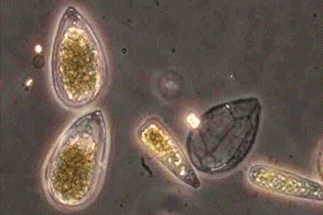All Asia & Oceania articles
-
 News
NewsHarnessing the positive health benefits of microbes
A new article introduces the ‘Database of Salutogenic Potential’, a world-first prototype open-access repository that catalogues microbes and natural compounds linked to positive health outcomes.
-
 News
NewsRising heat reshapes how microbes break down microplastics, new review finds
A new review examines how high and extreme temperatures influence the ability of microorganisms to degrade microplastics. The authors show that heat can both accelerate and suppress microbial breakdown of plastic particles, depending on conditions and the organisms involved.
-
 News
NewsA ‘one-pot’ assay of or rapid portable identification of genotypes I and II African swine fever viruses
Researchers in search of an African swine fever virus genotyping method developed an isothermal ‘one-pot’ CRISPR-Cas12i3/Cas13d-based assay, designated OBServe.v2, to detect two amplified targets from multiplex recombinase polymerase amplification (RPA) in a single tube.
-
 News
NewsScientists discover fungus that kills toxic algae threatening human health
A team of researchers have discovered a previously unknown species of marine fungus that can kill harmful, bloom-forming algae. The new species, Algophthora mediterranea, is a form of microscopic chytrid fungus that can occupy a broad range of hosts.
-
 News
NewsCOVID-19 leaves a lasting mark on the human brain
COVID-19 does not just affect the respiratory system, but also significantly alters the brain in people who have fully recovered from the infectious disease, highlighting the long-term neurological impact of the virus.
-
 News
NewsCan certain bacteria regulate aging of the immune system and its related alterations?
Researchers have discovered a strain of Lentilactobacillus capable of preventing and even reversing aging-related immune alterations. Feeding aged mice with heat-inactivated YRC2606 resulted in lowered levels of inflammatory cytokines and signaling proteins.
-
 News
NewsGut bacteria from amphibians and reptiles achieve complete tumor elimination
Researchers have discovered that the bacterium Ewingella americana, isolated from the intestines of Japanese tree frogs (Dryophytes japonicus), possesses remarkably potent anticancer activity.
-
 News
NewsHidden viruses in wastewater treatment may shape public health risks, study finds
A new study reveals that viral communities in wastewater treatment plants are far more complex and influential than previously recognized, with implications for water safety, antibiotic resistance, and how treatment performance is monitored.
-
 News
NewsWho is more likely to get long COVID?
Scientists have identified the key genetic drivers behind long COVID, revealing why some people continue to experience debilitating symptoms long after their initial infection.
-
 News
NewsStreptococcus suis serotype 2 collagenase-like protease promotes meningitis by increasing blood-brain barrier permeability
Streptococcus suis serotype 2 (SS2) is an emerging zoonotic pathogen that causes meningitis in humans and pigs. Researchers have investigated the role and mechanism of the SS2 Clp in promoting the passage of the bacterium across the blood-brain barrier (BBB).
-
 News
NewsMutated baker’s yeast at the forefront of petroleum substitute tech
Researchers engineering Saccharomyces cerevisiae to produce 2,3-butanediol (2,3-BDO) introduced mutations into the genomic DNA. The researchers engineered four altered strains and subjected them to ethanol, heat, and low pH stressors.
-
 News
NewsEngineering oncolytic bacteria as precision cancer therapeutics
A new review summarizes recent advances in the design and application of synthetic biological strategies that enhance bacterial precision, safety, and efficacy in tumor therapy.
-
 News
NewsApplications of AI in antimicrobial resistance prevention and control
Researchers have published a review shedding light on how AI is revolutionizing the prevention and control of AMR. The article illustrates how machine learning and deep learning are transforming surveillance, diagnosis, treatment optimization, and drug discovery.
-
 News
NewsScalable nanoengineered gauze with sustained natural product release
A multi-institutional Chinese research team has developed PPCZ@Gauze – a novel nanoengineered dressing that synergistically combines antibacterial, anti-adhesive, and pro-angiogenic functions.
-
 News
NewsScientists create microneedle system to deliver living biofertiliser directly into plants, boosting growth with less waste
A dissolving patch delivers beneficial microbes into leaves and stems, speeding growth in vegetables while using over 15 per cent less biofertiliser than soil application.
-
 News
NewsNew method to accelerate vaccine and drug development for norovirus
Researchers have developed a simple and efficient system for understanding the functions of specific norovirus genes, providing new avenues for developing antivirals and vaccines.
-
 News
NewsNew review reveals how microbial communities accelerate the global spread of antibiotic resistance
A new scientific review has uncovered how complex microbial communities, including those in the human gut and the natural environment, act as powerful engines that drive the evolution and spread of antimicrobial resistance.
-
 News
NewsInstitutions team up to advance first AI-designed mRNA vaccine against deadly tick-borne disease
Scientists are developing what could become the world’s first mRNA vaccine against severe fever with thrombocytopenia syndrome (SFTS)—a tick-borne viral disease associated with this condition.
-
 News
NewsEverolimus alleviates ulcerative colitis via inflammation suppression and microbiota remodeling
A new study reveals how targeting the CLEC4E receptor and reshaping the gut metabolite axis offers a promising therapeutic avenue for inflammatory bowel disease.
-
 News
NewsHow did Bronze Age plague spread? Ancient sheep might solve the mystery
Researchers have found the first evidence of a Bronze Age plague infection in a non-human host. The scientists discovered Y. pestis DNA in a 4,000-year-old domesticated sheep from Arkaim, a fortified settlement located in the Southern Ural Mountains of present-day Russia.
